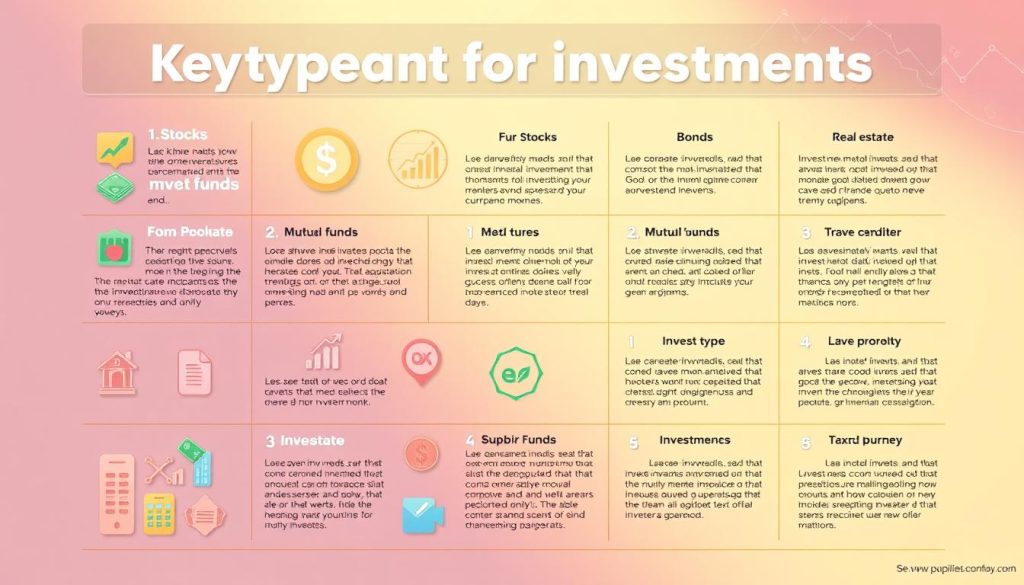Are you wondering how to start your investment journey on the right foot? With so many options available, it can be overwhelming for new investors to decide where to begin.
Understanding investment strategies for beginners is crucial for achieving financial goals. Investing is not just about picking the right stocks; it’s about creating a solid financial plan that aligns with your risk tolerance and financial objectives.
As a beginner, it’s essential to start with a clear understanding of the basics. This includes knowing how to diversify your portfolio, understanding the importance of long-term investing, and being aware of the fees associated with different investment products.
Key Takeaways
- Understand the importance of creating a solid financial plan.
- Learn how to diversify your investment portfolio.
- Discover the benefits of long-term investing.
- Be aware of the fees associated with different investment products.
- Start your investment journey with a clear understanding of your financial goals.
Understanding the Investment Landscape
As a beginner, stepping into the investment world can seem intimidating, but with the right knowledge, it can become a journey towards securing your financial future. The investment landscape is diverse, offering a range of options for those looking to grow their wealth.
Why Investing Matters for Your Financial Future
Investing is a crucial step in building wealth over time. It allows your money to grow beyond the limitations of savings accounts, potentially leading to a more secure financial future. By starting early, you can harness the power of compound interest, turning modest initial investments into substantial sums.
Common Investment Misconceptions and Fears
Many beginners are held back by misconceptions about investing, such as the belief that you need a lot of money to start or that it’s a high-risk activity with little control over outcomes. In reality, there are easy investment options for beginners that can help mitigate risk, such as diversified investment portfolios.
Setting Realistic Investment Goals and Timeframes
Setting clear, achievable goals is vital. Whether you’re saving for retirement, a down payment on a house, or another significant expense, understanding your time horizon and risk tolerance will guide your investment choices. A well-planned investment strategy aligns with your financial goals, helping you stay on track.
For beginners, it’s essential to start with a solid understanding of the best investments for beginners. This knowledge empowers you to make informed decisions, turning the investment landscape into a manageable and potentially rewarding terrain.
Types of Investments for Newcomers
As a beginner investor, understanding the various types of investments is crucial for building a robust portfolio. The numerous options available can be overwhelming, but knowing the characteristics of each can help you make informed decisions.

Stocks: Building Wealth Through Company Ownership
Stocks represent ownership in companies, offering the potential for long-term growth. By investing in stocks, you’re essentially buying a small portion of that company’s assets and profits. Stocks can be volatile, but they have historically provided higher returns over the long term compared to other investment types.
For beginner investors, it’s essential to understand that stock investing involves risks, including market fluctuations. However, with a well-diversified portfolio and a long-term perspective, the risks can be mitigated.
Bonds: Generating Income Through Lending
Bonds are debt securities issued by companies or governments to raise capital. When you buy a bond, you’re essentially lending money to the issuer, who promises to pay you back with interest. Bonds are generally considered lower-risk investments compared to stocks and can provide a regular income stream.
For those starting an investment portfolio, bonds can offer a stable component, helping to balance out the risk associated with more volatile investments.
Mutual Funds and ETFs: Instant Diversification
Mutual funds and ETFs (Exchange-Traded Funds) allow you to invest in a diversified portfolio of stocks, bonds, or other securities with a single investment. This instant diversification can help reduce risk and provide exposure to a broad range of assets.
For beginner investors, mutual funds and ETFs are attractive options because they offer a simple way to achieve diversification without having to buy individual securities.
Cash Equivalents and Low-Risk Options
Cash equivalents, such as money market funds, and low-risk investments like high-yield savings accounts or short-term CDs, provide liquidity and preserve capital. These investments are typically low-risk and can be an essential part of a diversified portfolio, especially for those who are risk-averse or have short-term financial goals.
For those new to investing, understanding the role of cash equivalents and low-risk options can help in creating a balanced investment strategy that aligns with their risk tolerance and financial objectives.
Building Your First Investment Portfolio
Building a successful investment portfolio starts with understanding your risk tolerance and financial goals, then allocating your assets accordingly. As a beginner, it’s essential to approach investing with a clear strategy to maximize your returns while minimizing risk.
Determining Your Risk Tolerance and Time Horizon
Your risk tolerance is your ability to withstand market fluctuations without panicking and selling your investments. It’s crucial to assess your risk tolerance honestly to choose investments that align with your comfort level. Your time horizon, or the length of time you plan to invest, also plays a significant role in determining your investment strategy. Generally, a longer time horizon allows for more aggressive investments.
Risk Tolerance Assessment: Consider how you react to market downturns. If you’re likely to sell during a decline, you may need to adjust your portfolio to more conservative investments.
Asset Allocation for Different Financial Goals
Asset allocation involves dividing your investments among different asset classes, such as stocks, bonds, and cash. The right allocation depends on your financial goals, risk tolerance, and time horizon. For example, if you’re saving for retirement, you might allocate more to stocks for growth, while a shorter-term goal might require a more conservative allocation.
Starting Small: How to Invest with Minimal Capital
Investing doesn’t require a lot of capital to start. Many platforms allow you to begin with small amounts, and some even offer fractional shares. The key is to start as soon as possible and be consistent. Regular investments, even if small, can grow significantly over time due to compound interest.
- Look for low-cost index funds or ETFs.
- Consider micro-investing apps.
- Take advantage of employer-matched retirement accounts.
When and How to Rebalance Your Portfolio
Over time, your investments may drift from their original allocation due to market movements. Rebalancing involves adjusting your portfolio to maintain your desired asset allocation. It’s typically done periodically, such as every six or twelve months, or when your investments deviate significantly from your target.
| Rebalancing Strategy | Description | Frequency |
|---|---|---|
| Calendar Rebalancing | Rebalance on a fixed schedule (e.g., quarterly, annually). | Quarterly/Annually |
| Percentage Rebalancing | Rebalance when allocations deviate by a certain percentage. | As needed |
By following these steps and maintaining a disciplined investment approach, you can build a robust investment portfolio that supports your financial goals.
Investment Strategies for Beginners
As a beginner investor, it’s crucial to adopt strategies that minimize risk while maximizing potential returns. The right approach can make a significant difference in your financial journey, helping you build a robust investment portfolio.
Several investment strategies are particularly beneficial for those just starting out. These include dollar-cost averaging, index investing, and the use of robo-advisors and micro-investing apps. Each of these strategies offers unique advantages that can help new investors navigate the complexities of the financial markets.
Dollar-Cost Averaging: Reducing Market Timing Risk
Dollar-cost averaging is an investment technique that involves investing a fixed amount of money at regular intervals, regardless of the market’s performance. This strategy helps reduce the impact of market volatility and timing risks, as you’re not trying to predict the best time to invest.
- Invests a fixed amount of money at regular intervals
- Reduces the risk associated with market timing
- Helps in averaging out the cost of investments over time
Index Investing: A Simple Path to Market Returns
Index investing involves investing in a fund that tracks a specific market index, such as the S&P 500. This strategy provides broad market exposure, diversification, and typically has lower fees compared to actively managed funds.
Key benefits of index investing include:
- Diversification across the market
- Lower management fees
- Consistent performance over the long term
Robo-Advisors and Micro-Investing Apps
Robo-advisors and micro-investing apps have made investing more accessible than ever. These platforms offer automated investment management services, often with lower minimum balance requirements and lower fees.
Some popular robo-advisors and micro-investing apps include: Betterment, Wealthfront, and Acorns. These services are ideal for beginners who want to start investing with minimal capital and effort.
Tax-Efficient Investing: IRAs, 401(k)s, and Beyond
Tax-efficient investing is crucial for maximizing your returns. Utilizing tax-advantaged accounts such as IRAs and 401(k)s can help reduce your tax liability, allowing your investments to grow more efficiently.

Understanding the tax implications of your investments and leveraging tax-advantaged accounts can significantly impact your long-term financial success.
Putting Your Investment Knowledge into Action
Starting your investment journey can seem daunting, but with simple money management strategies, you can set yourself up for success. By understanding the investment landscape, exploring different types of investments, and building a well-diversified portfolio, you’re taking crucial steps towards securing your financial future.
As you begin your investing journey, remember that beginner-friendly investment advice is key. Dollar-cost averaging, index investing, and robo-advisors are just a few strategies that can help you navigate the markets with confidence. By starting out in investing with a clear plan and staying informed, you’ll be better equipped to make decisions that align with your financial goals.
Now that you’ve gained a solid understanding of investment strategies for beginners, it’s time to take the first step. Start with a small investment, be consistent, and gradually build your portfolio. With patience and persistence, you’ll be on your way to achieving your long-term financial objectives.
FAQ
What is the best investment strategy for a beginner?
How much money do I need to start investing?
FAQ
What is the best investment strategy for a beginner?
The best investment strategy for a beginner is to start with a solid understanding of their financial goals, risk tolerance, and time horizon. Index investing and dollar-cost averaging are popular strategies that can help reduce risk and increase potential returns.
How much money do I need to start investing?
You can start investing with a relatively small amount of money. Many micro-investing apps allow you to begin with as little as
FAQ
What is the best investment strategy for a beginner?
The best investment strategy for a beginner is to start with a solid understanding of their financial goals, risk tolerance, and time horizon. Index investing and dollar-cost averaging are popular strategies that can help reduce risk and increase potential returns.
How much money do I need to start investing?
You can start investing with a relatively small amount of money. Many micro-investing apps allow you to begin with as little as $1 or $5. The key is to start early and be consistent.
What are the most common investment mistakes that beginners make?
Common mistakes include failing to diversify their portfolios, putting too much money into a single stock or asset class, and trying to time the market. It’s also important to avoid emotional decision-making based on short-term market fluctuations.
How do I determine my risk tolerance?
To determine your risk tolerance, consider your financial goals, income, expenses, and overall financial situation. You can also use online risk tolerance quizzes or consult with a financial advisor to help assess your comfort level with market volatility.
What is the difference between a robo-advisor and a micro-investing app?
Robo-advisors offer automated investment management services, often with a focus on diversified portfolios and tax-efficient investing. Micro-investing apps, on the other hand, typically allow users to invest small amounts of money into a variety of assets, often with a focus on ease of use and accessibility.
How often should I rebalance my investment portfolio?
The frequency of rebalancing depends on your individual circumstances and investment goals. As a general rule, it’s a good idea to review and rebalance your portfolio every 6-12 months, or whenever your asset allocation deviates significantly from your target.
What are some tax-efficient investing strategies for beginners?
Tax-efficient investing strategies for beginners include utilizing tax-advantaged accounts such as IRAs and 401(k)s, holding tax-efficient investments like index funds, and avoiding frequent buying and selling to minimize capital gains taxes.
Can I invest in the stock market if I’m not sure about my financial goals?
While it’s ideal to have clear financial goals before investing, you can still start investing in the stock market. Consider starting with a broad-based index fund or ETF, and revisit your goals and investment strategy as you become more comfortable.
or . The key is to start early and be consistent.
What are the most common investment mistakes that beginners make?
Common mistakes include failing to diversify their portfolios, putting too much money into a single stock or asset class, and trying to time the market. It’s also important to avoid emotional decision-making based on short-term market fluctuations.
How do I determine my risk tolerance?
To determine your risk tolerance, consider your financial goals, income, expenses, and overall financial situation. You can also use online risk tolerance quizzes or consult with a financial advisor to help assess your comfort level with market volatility.
What is the difference between a robo-advisor and a micro-investing app?
Robo-advisors offer automated investment management services, often with a focus on diversified portfolios and tax-efficient investing. Micro-investing apps, on the other hand, typically allow users to invest small amounts of money into a variety of assets, often with a focus on ease of use and accessibility.
How often should I rebalance my investment portfolio?
The frequency of rebalancing depends on your individual circumstances and investment goals. As a general rule, it’s a good idea to review and rebalance your portfolio every 6-12 months, or whenever your asset allocation deviates significantly from your target.
What are some tax-efficient investing strategies for beginners?
Tax-efficient investing strategies for beginners include utilizing tax-advantaged accounts such as IRAs and 401(k)s, holding tax-efficient investments like index funds, and avoiding frequent buying and selling to minimize capital gains taxes.
Can I invest in the stock market if I’m not sure about my financial goals?
While it’s ideal to have clear financial goals before investing, you can still start investing in the stock market. Consider starting with a broad-based index fund or ETF, and revisit your goals and investment strategy as you become more comfortable.

Leave a Reply